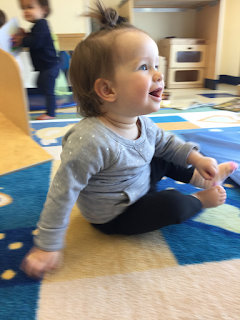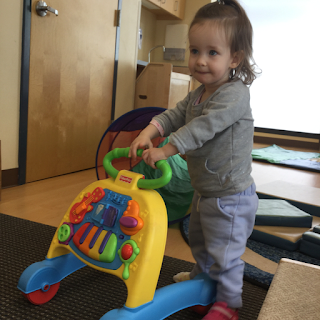A little thing happened since we
last chatted…
Just when we were starting to
think that Amelie was going to scoot across the stage to receive her high
school diploma, Amelie proved yet again, that she marches to the beat of
her own drummer not ours. In doing so, she taught me a valuable lesson about
motor learning that greatly impacts how I engage in this process in the clinic.
**Special thanks to Joe Hannigan (Skyline's student-extraordinaire) who helped lay the foundation for this blog post with his incredible motor
learning in-service!
10,000 Foot View:
What is motor learning? Motor learning is a relatively permanent change in the
ability to execute a motor skill as a result of practice or experience1.
In our Amelie case study, the motor skill of interest is walking.
Amelie (and Joe) helped me realize that there are 3 crucial
tenets of motor learning that must be addressed in order to achieve
a successful outcome: salience, specificity, and intensity2.
1. Salience
– importance to the person. Amelie was not going to engage in the process of
learning to walk unless she found it important to her. Judging by the look on
her face while scooting, she was in no rush to give this form of locomotion up.
Salience is crucial. If the learner
does not connect with the perceived importance of the task, then they will not
be willing to put in the work (and it is a lot of work) to master the skill.
2. Specificity
– the proverbial steps on the journey to walking must be
specific to the end goal – walking – not scooting, not crawling, not climbing.
No matter how beneficial these tactics might be in the development of strength,
mobility, and endurance (more on these to come), task specificity is walking.
3. Intensity
– motor learning requires the learner to push themselves
out of their comfort zone, over and over again.
Precursor to motor learning:
Capacity (mobility, strength,
endurance) is a precursor to motor learning – establish capacity first3.
Or, in the words of our fearless leader, Richard Jackson: Stretch ->
Strengthen -> Functionally Retrain.
Even if Amelie decides that it is
important to learn to walk, she must possess the requisite capacity to engage
in the learning process.
I have spent a lot of time
reflecting on capacity as a foundation for learning. What are the metrics that
I can use to track mobility, strength, and endurance? Do these metrics directly
relate back to the end goal of the motor skill? Remember, two of the keys to
motor learning are salience (importance to the person) and specificity. If you
are building a foundation of mobility, strength and endurance that is specific
to the movement of concern and is important to the patient, you are on your
way!
Low Hanging Fruit:
We can challenge intensity through4:
1. Feedback - How does Amelie know if she is improving her
walking? The ideal feedback is dichotomous – easy to determine pass vs fail. In Amelie’s case,
fail equals falling. Everything else is a pass. This feedback is immediate and
specific to the task.
I am constantly working to
improve the feedback I give my patients. Is my feedback something tangible for
the patient (don’t fall) or is it some nebulous cue to engage some deep muscle
that they cannot identify or pronounce, let alone engage? As the learner improves,
you can alter the feedback to enhance learning. This can come in the form of
reducing the frequency of the feedback, changing the input of feedback (visual
cue vs auditory cue), or providing summative feedback rather than feedback in
the moment - just to name a few. The iterations of feedback are endless, but I try to make sure the
feedback is dichotomous and salient to the learner.
2. Weight – Amelie
worked to modify weight by first walking with a rolling walker.
As she becomes a more proficient
walker, Amelie will begin walking while wearing a weight vest. What are we without progress :) ?
3. Environment
– Early in the learning process, Amelie practiced walking in a controlled
environment, where we could limit distractions and obstacles to her
performance (our house). From here, she progressed to environments that
were less controlled and had more potential distractions (daycare).
Eventually, she progressed to chasing every dog in Shirlington Village,
screaming “bow wow wow” and giggling with glee.
Remember – just because your patient
performs a skill in the clinic, does not ensure the same success in the outside
world. Practice in the environment in which they will have to perform.
4. Dual task –
Involves divided attention in the performance of the skill. In Amelie’s
case, this most frequently involves singing Baby Shark while pushing her
walker.
5. Speed/accuracy
– This was best tested through chasing our cats around the house. Can
Amelie catch the cats? To do so, she needs speed. Can she successfully grab
their tails? To do so, she needs accuracy. These are parameters of
intensity that Rebecca does not support nearly as enthusiastically as I
do.
*Disclaimer – no cats were harmed in the making of this blog post.
6. Practice – Our method of exploration.
Practice the task. Learn the limits of your capabilities and improve them. In
the book Peak: Secrets from the New
Science of Expertise, Anders Ericsson describes deliberate practice as the gold
standard to building new skills and abilities.
What is deliberate practice? Practice that is purposeful and systematic. Deliberate
practice demands near-maximal effort, which is generally not enjoyable. This
goes back to the idea that you need the requisite foundational skills
(mobility, strength, endurance) to even allow yourself to engage in deliberate
practice. Additionally, deliberate practice depends on effective mental
representations of the task - make it possible to monitor how one is doing.
This is critical! What does successful performance look like? The answer should
be clear and concrete.
7. Error – We
learn through trial and error. Amelie did not read any books on the
mechanics of walking (despite my encouragement to do so) or listen to my
futile attempts to lecture her on the importance of walking. She learned
to walk through trial and error (once she decided it was important for her
to learn to walk). This also ties back to the point about feedback - The
error with Amelie’s walking is a fall. Anything else is a success. This is
a clear method for assessment, did I fall? Yes = fail. No = pass. Amelie
does not need me to tell her if she passed or not. Your goal with any
motor learning task is to set up a clear dichotomy of consequences –
pass/fail.
What Did I Learn?
I cannot force motor learning. It
is something that I can only nurture when Amelie is ready and when it is
important to her. Thank you Amelie, for yet another incredible life lesson.
References:
1. Haibach-Beach P, Reid G, Collier D. Motor Learning and
Development – 2nd Edition.
2. Motor Learning – An Application in the Orthopedic Setting. In-Service
– Joe Hannigan, SPT – 3/19
3. Understanding Human Movement as a Dynamical System – Erik Meira
(2018) – as part of the course: Complex Understandings for Simple Solutions
4. Mowder-Tinney
and Streeter 2018: Translating Motor Learning into Practice: What is M.I.A.
from your patient care?
5. Ericcson KA, Pool R. Peak: Secrets from the New Science of
Expertise (2016)

